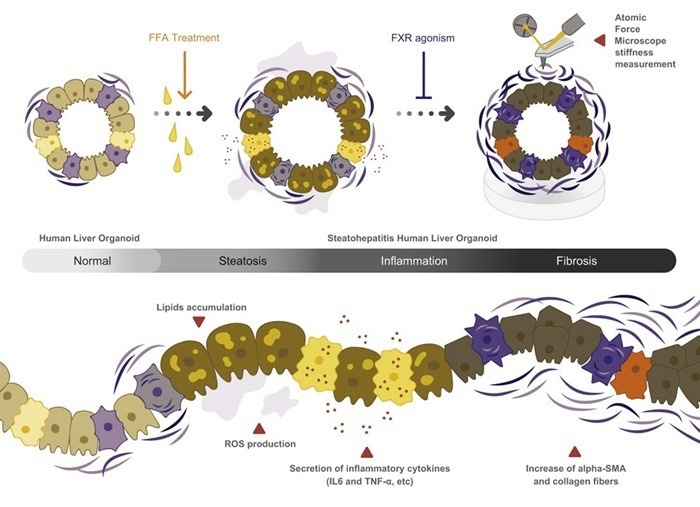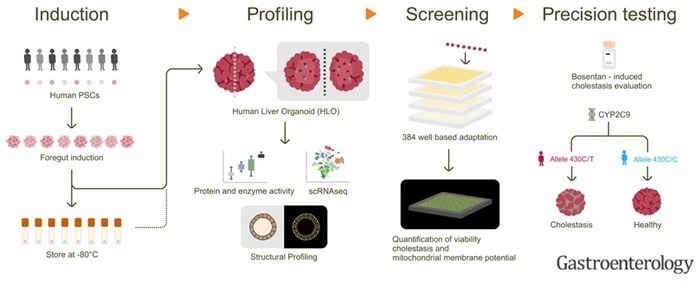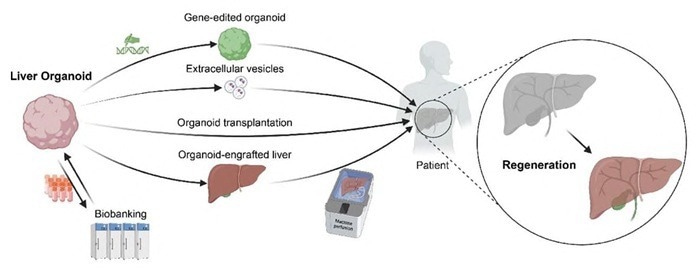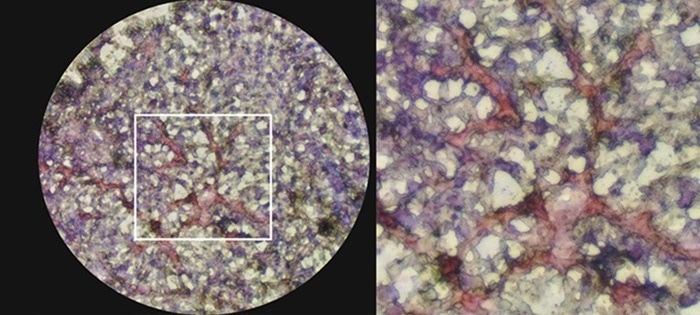Organoids are miniature organs made up of different cell types that exhibit similar structures and functions to real organs.
Organoids more closely reflect human physiological and pathological features than traditional cell cultures. Researchers regularly use organoids to model organs such as the cardiac system, liver, brain, and intestine in order to develop models for diseases like neurodegenerative disorders, cancer, and genetic diseases.
Organoid-based models are used widely in research, from studying disease mechanisms and development to assessing drug efficacy and toxicity. They also play a key role in advancing precision therapies and personalised medicine.

ACROBiosystems' brain, cardiac, liver, and intestinal organoids. Image Credit: ACROBiosystems
Liver organoids: Cutting-edge tools for simulating liver function and disease research
The liver is a key metabolic organ required for metabolism, detoxification, and nutrient storage. The liver’s basic functional unit is the hepatic lobule. This hexagonal structure features the central vein at its center, while the hepatic artery and portal vein enter from the hepatic lobule’s periphery to ensure oxygen and nutrient supply. The hepatic lobule is key to liver metabolism and detoxification.
Liver organoids can effectively mimic the liver's physiological structure and functions. They can also recreate a range of cell types, including hepatocytes, bile duct cells, and the hepatic lobular structure.
This in vitro model offers a diverse cell composition and a highly biomimetic structure, making it invaluable in research on liver disease modeling, regenerative medicine, and drug development.

ACROBiosystems' liver organoids (Cat. No. CIPO-RWL005K) exhibit the typical hexagonal structure of the hepatic lobule. Image Credit: ACROBiosystems
Application of liver organoids in disease modeling
Non-alcoholic fatty liver disease (NAFLD) is the world’s most widespread chronic liver disease. This disease progresses from simple steatosis to non-alcoholic steatohepatitis (NASH), potentially advancing to hepatocellular carcinoma and liver fibrosis.
Liver organoids represent an invaluable in vitro model for the study of these diseases. For instance, Ouchi et al. developed liver organoids made up of stellate cells, hepatocyte cells, and Kupffer cells.
These organoids were able to closely mimic in vivo liver tissue at the transcriptome level, inducing lipid accumulation under free fatty acid (FFA) treatment and gradually exhibiting key NASH features, including inflammation, steatosis, and fibrosis.

Liver organoids treated with FFA gradually exhibit key features of NASH. Image Credit: https://doi.org/10.1016/j.cmet.2019.05.007
The importance of liver organoids in drug screening
One common cause of acute liver failure and drug withdrawals is drug-induced liver injury (DILI). Liver organoids represent a reliable in vitro model for the study of DILI and have proven to be highly valuable in new drug screening and drug toxicity assessment.
For instance, Shinozawa et al. successfully developed a liver organoid-based toxicity screening system, allowing them to evaluate a total of 238 marketed drugs, including 206 reported DILI drugs and 32 negative controls. Results of this study revealed high accuracy and reliability in the prediction of liver toxicity.
Hendriks et al. also used liver organoids to screen 17 NAFLD drug candidates, successfully identifying a number of compounds that effectively alleviated steatosis.

Drug toxicity screening system based on liver organoids. Image Credit: https://doi.org/10.1053/j.gastro.2020.10.002
The potential of liver organoids in regenerative medicine
Liver organoids offer potential in the field of regenerative medicine, with studies highlighting liver organoids’ potential to improve therapeutic outcomes by partially replacing damaged liver tissue as functional units.
For instance, Huch et al. successfully enhanced survival rates by transplanting mouse liver organoids derived from adult stem cells into a tyrosinemia type I mouse model.
Research by Takebe et al. demonstrated that vascularised liver organoids derived from induced pluripotent stem cells (iPSCs) formed vascular structures within 48 hours of transplantation and were able to rescue mice with drug-induced liver injury. The study highlights the effectiveness and therapeutic potential of organoid transplantation.

Drug toxicity screening system based on liver organoids. Image Credit: https://doi.org/10.3350/cmh.2024.1040
ACROBiosystems’ liver organoids for NASH modeling
NASH is a chronic liver disease characterized by inflammation, fat accumulation, and liver damage. NASH is closely linked to type 2 diabetes, obesity, and metabolic syndrome.
Oil Red dye can be used to detect intracellular lipid deposition, visualizing fatty acid accumulation in liver organoids. When liver organoids (Cat. No. CIPO-RWL005K) were stained with Oil Red, they showed marked fatty acid build-up, displaying pathological features characteristic of NASH.
This reliable in vitro model can be used to support ongoing research into NASH pathogenesis, as well as aid in the evaluation of potential therapeutic strategies.

Oil Red staining shows significant fatty acid accumulation in ACROBiosystems liver organoids. Image Credit: ACROBiosystems
Conclusion
Liver organoids’ capacity to closely mimic human organ structure and function is key to their usefulness and applicability in drug development and disease research. ACROBiosystems is dedicated to furthering the development of organoid technology, offering a comprehensive portfolio of high-quality tools designed for novel drug development and disease studies.
References and further reading
- Sang, C., et al. (2024). Progress, application and challenges of liver organoids. Clinical Cancer Bulletin, 3(1). https://doi.org/10.1007/s44272-024-00012-0.
- Ouchi, R., et al. (2019). Modeling Steatohepatitis in Humans with Pluripotent Stem Cell-Derived Organoids. Cell Metabolism, (online) 30(2). https://doi.org/10.1016/j.cmet.2019.05.007.
- Shinozawa, T., et al. (2021). High-Fidelity Drug-Induced Liver Injury Screen Using Human Pluripotent Stem Cell–Derived Organoids. Gastroenterology, 160(3), pp.831-846.e10. https://doi.org/10.1053/j.gastro.2020.10.002.
- Hendriks, D., et al. (2023). Engineered human hepatocyte organoids enable CRISPR-based target discovery and drug screening for steatosis. Nature Biotechnology. https://doi.org/10.1038/s41587-023-01680-4.
- Huch, M., et al. (2013). In vitro expansion of single Lgr5+ liver stem cells induced by Wnt-driven regeneration. Nature, 494(7436), pp.247–250. https://doi.org/10.1038/nature11826.
- Takebe, T., et al. (2013). Vascularized and functional human liver from an iPSC-derived organ bud transplant. Nature, 499(7459), pp.481–484. https://doi.org/10.1038/nature12271.
- Kim, Y., et al. (2025). Liver organoids: Current advances and future applications for hepatology. Clinical and Molecular Hepatology, (online) 31(Suppl), pp.S327–S348. https://doi.org/10.3350/cmh.2024.1040.
Acknowledgments
Produced from materials originally authored by ACROBiosystems.
About ACROBiosystems
ACROBiosystems is a cornerstone enterprise of the pharmaceutical and biotechnology industries. Their mission is to help overcome challenges with innovative tools and solutions from discovery to the clinic. They supply life science tools designed to be used in discovery research and scalable to the clinical phase and beyond. By consistently adapting to new regulatory challenges and guidelines, ACROBiosystems delivers solutions, whether it comes through recombinant proteins, antibodies, assay kits, GMP-grade reagents, or custom services. ACROBiosystems empower scientists and engineers dedicated towards innovation to simplify and accelerate the development of new, better, and more affordable medicine.
Sponsored Content Policy: News-Medical.net publishes articles and related content that may be derived from sources where we have existing commercial relationships, provided such content adds value to the core editorial ethos of News-Medical.Net which is to educate and inform site visitors interested in medical research, science, medical devices and treatments.